- Joined
- Sep 3, 2013
- Messages
- 2,385
OUCH!! So sorry to hear that!
Prayers outgoing for a quick recovery.
Thanks, @Karl_K , much appreciated!
A couple of black and white photos for you.
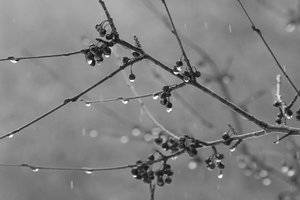
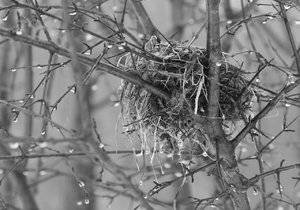
OUCH!! So sorry to hear that!
Prayers outgoing for a quick recovery.


Awesome!!!! Thanks!!!!
Wednesday morning, I went out to take photos.
It was foggy and raining.
The rain made the ice extra-slippery.
This duck flew in to land on the ice by the river, and the slippery conditions resulted in a bumpy landing.
I laughed.
An hour later, I slipped on the ice and broke my wrist.
Morale of the story: Never laugh at a duck.
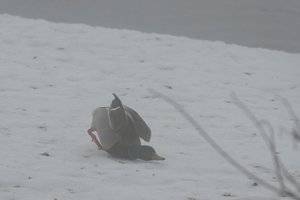
Nice Karl.
I thought about doing it myself, but thought I would be more fun if you jumped in, since there are so many ways to do a B&W.
Looking at the nice one you have done, am I correct in thinking that you worked with the adjusted one? I think there is more detail, near the base of the rock especially, than you would have gotten from the unadjusted one.
Wink
Ouch, that is a distressing story. I hope it heals quickly. I also hope you did not hurt your new camera!
When I was a young teenager I went with my father to my grandfather's hunting club. It had been bitterly cold for some time and the water was largely frozen over. It had warmed up overnight though, and rained during the early morning hours and the ice was now covered with a skiff of water.
The ducks would come in and land on the water and go sliding and spinning across the pond. None of us had cameras with us then, too bad as the pictures would have been priceless. A good video would have made our fortune, but in the late 50's video cameras were not common in the hands of teenagers.
Since we would not shoot before the ducks landed, and of course once they land it is considered poor sportsmanship to shoot them on the water, we shot very little that morning. It was however, one of my favorite days of hunting. It still ranks in the top 5 of my life. Watching the birds on the pond pretend like they did it on purpose and then calling to their friends to come down and do it too.
Wink
Ahhh, the very rare black, grey and almost white duck.
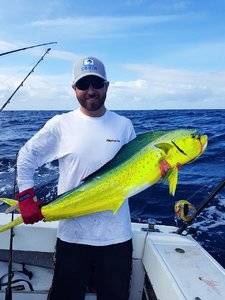
Here's a colourful picture; a Mahi Mahi showing amazing green and golds with a deep cobalt blue ocean in the background. The little yellow streamer you can see in it's back is a serial number tag, it's now being tracked by scientists in hope it gets caught again. They are one of the best eating fish in the ocean and I have never thrown one back even half that size. I am still hurting inside slightly however we had no cold storage for the fillets and no way to cook it fresh at the motel we were staying at. So she went back (yes, it is a female).
I should have worn a black t shirt to balance out the brightness in the pic
Here's a colourful picture; a Mahi Mahi showing amazing green and golds with a deep cobalt blue ocean in the background. The little yellow streamer you can see in it's back is a serial number tag, it's now being tracked by scientists in hope it gets caught again. They are one of the best eating fish in the ocean and I have never thrown one back even half that size. I am still hurting inside slightly however we had no cold storage for the fillets and no way to cook it fresh at the motel we were staying at. So she went back (yes, it is a female).
I should have worn a black t shirt to balance out the brightness in the pic
Here's a colourful picture; a Mahi Mahi showing amazing green and golds with a deep cobalt blue ocean in the background. The little yellow streamer you can see in it's back is a serial number tag, it's now being tracked by scientists in hope it gets caught again. They are one of the best eating fish in the ocean and I have never thrown one back even half that size. I am still hurting inside slightly however we had no cold storage for the fillets and no way to cook it fresh at the motel we were staying at. So she went back (yes, it is a female).
I should have worn a black t shirt to balance out the brightness in the pic
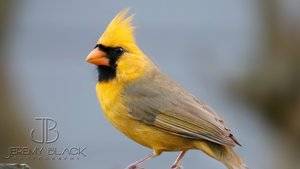
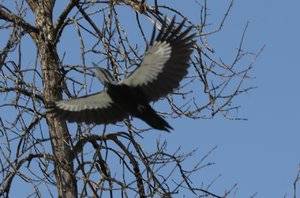
Its thinking.....A cute squirrel ... is there any other kind?
A couple of my photos - first up, a female Pileated Woodpecker flying overhead out in the woods.
I was in the process of trying to get to a better location for a photo when she took off from the tree she'd been at.
Not the shot I was going for, but it shows the white on the underside of this large bird's wings.
Some birds have lovely colours/patterning that is concealed if their wings aren't spread.

Just curious. What focus mode are you using on your camera? Are you using back button focus or shutter button focus? Are you using auto focus or ???
Wink
I always use auto focus (AF), never manual.
The type of AF offered is as follows:
1. ONE SHOT; for still subjects.
2. AI SERVO; for moving subjects.
3. AI FOCUS; for subjects that are still but might start moving. So the camera switches automatically from ONE SHOT (setting focus on the still subject) to AI SERVO if the subject starts to move.
The camera has a 65 AF points, so I can choose the points or area within which I want the camera to get focus.
With birds in flight, I'm always using AI SERVO.
I have one focus point with four points around it as the 'area' within which to look for the subject, although I tried 8 points as well, I think.
I think minimizing the 'area' reduces the time required to find the subject and get focus, but I could be wrong. Just something I think I read some time ago.
With still subjects, such as the squirrel above, I use ONE SHOT and select a single point as my 'area' so that I can get a specific desired point in focus; normally/always the subject's eye.
I have the option of placing equal priority on focusing and shutter, or changing the priority to ensure focus is achieved before the shutter opens, or vice versa. I haven't played with this yet, but thinking I'll try with placing the top priority on achieving focus before the first photo. The difference might be insignificant, but something to try.
There are also AI SERVO Characteristics, with six pre-set cases, and I believe the option to set others. For example, Case 2 continues to track the subject and ignores possible obstacles; such as a bird I'm tracking flies behind a tree between me and him, reappearing on the other side. Case 3 will switch the focus off the subject if a new subject suddenly enters the selected AF area. Case 4 is for subjects that accelerate or decelerate quickly. Case 6 is for subjects that change speed and move erratically. I haven't played with this (yet) and so its just set at Case 1 which is a versatile multipe-purpose setting for any moving subject.
I don"t use back button focusing, but have recently been watching videos on it that seem to strongly suggest its use. When I tried pressing the back button, without setting it, it seemed awkward to me, as though y hand was a bit too small to comfortably reach the button with holding the camera steady and securely. I'll try again (after I'm freed of the cast) because it seems as though it would be beneficial.
All that rambling to say that I usually have my camera on AI SERVO with a small focus area, switching to ONE SHOT if I'm in a wooded area shooting still subjects. In the woods, there are so many branches that a clear shot of a bird in flight is unlikely.
Of course, the photo of the pileated woodpecker above shows why we never say never. Nothing seems in focus in that shot! Walking off the path in deep snow and suddenly seeing her overhead was not according to plan.
Any and all photography comments/suggestions/etc. are appreciated, Wink. I try to continually learn about my camera, photography and improve upon the results.

I asked only because it is so unusual to see an out of focus shot from you.